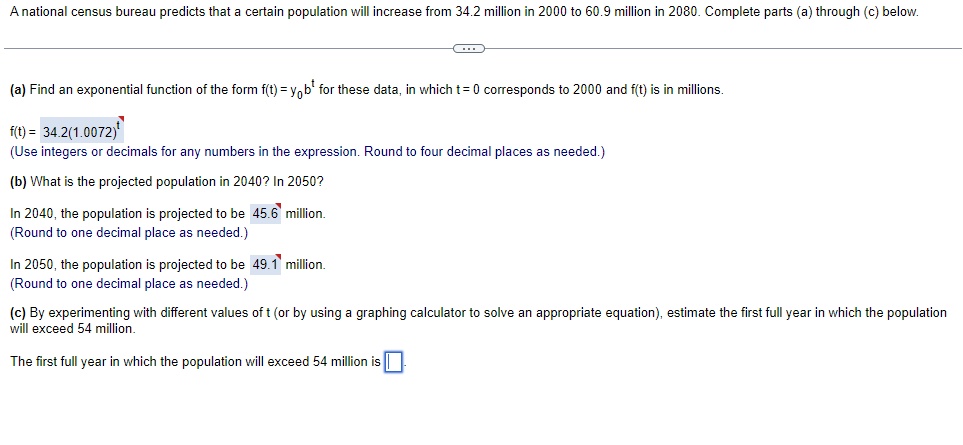A national census bureau predicts that a certain population will increase from 34.2 million in 2000 to 60.9 million in 2080. Complete parts (a) through (c) below. (a) Find an exponential function of the form f(t) = Y,b' for these data, in which t= 0 corresponds to 2000 and f(t) is in millions. f(t) = 34.2(1.0072) (Use integers or decimals for any numbers in the expression. Round to four decimal places as needed.) (b) What is the projected population in 2040? In 2050? In 2040, the population is projected to be 45.6 million. (Round to one decimal place as needed.) In 2050, the population is projected to be 49.1 million. (Round to one decimal place as needed.) (c) By experimenting with different values of t (or by using a graphing calculator to solve an appropriate equation), estimate the first full year in which the population will exceed 54 million. The first full year in which the population will exceed 54 million is |
A national census bureau predicts that a certain population will increase from 34.2 million in 2000 to 60.9 million in 2080. Complete parts (a) through (c) below. (a) Find an exponential function of the form f(t) = Y,b' for these data, in which t= 0 corresponds to 2000 and f(t) is in millions. f(t) = 34.2(1.0072) (Use integers or decimals for any numbers in the expression. Round to four decimal places as needed.) (b) What is the projected population in 2040? In 2050? In 2040, the population is projected to be 45.6 million. (Round to one decimal place as needed.) In 2050, the population is projected to be 49.1 million. (Round to one decimal place as needed.) (c) By experimenting with different values of t (or by using a graphing calculator to solve an appropriate equation), estimate the first full year in which the population will exceed 54 million. The first full year in which the population will exceed 54 million is |
Algebra & Trigonometry with Analytic Geometry
13th Edition
ISBN:9781133382119
Author:Swokowski
Publisher:Swokowski
Chapter5: Inverse, Exponential, And Logarithmic Functions
Section: Chapter Questions
Problem 15T
Related questions
Question

Transcribed Image Text:A national census bureau predicts that a certain population will increase from 34.2 million in 2000 to 60.9 million in 2080. Complete parts (a) through (c) below.
(a) Find an exponential function of the form f(t) = V.b' for these data, in which t= 0 corresponds to 2000 and f(t) is in millions.
f(t) = 34.2(1.0072)
(Use integers or decimals for any numbers in the expression. Round to four decimal places as needed.)
(b) What is the projected population in 2040? In 2050?
In 2040, the population is projected to be 45.6 million.
(Round to one decimal place as needed.)
In 2050, the population is projected to be 49.1 million.
(Round to one decimal place as needed.)
(c) By experimenting with different values of t (or by using a graphing calculator to solve an appropriate equation), estimate the first full year in which the population
will exceed 54 million.
The first full year in which the population will exceed 54 million is
Expert Solution
This question has been solved!
Explore an expertly crafted, step-by-step solution for a thorough understanding of key concepts.
This is a popular solution!
Trending now
This is a popular solution!
Step by step
Solved in 4 steps

Recommended textbooks for you

Algebra & Trigonometry with Analytic Geometry
Algebra
ISBN:
9781133382119
Author:
Swokowski
Publisher:
Cengage


Algebra & Trigonometry with Analytic Geometry
Algebra
ISBN:
9781133382119
Author:
Swokowski
Publisher:
Cengage
